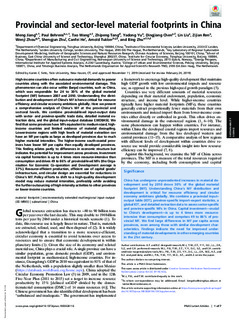| dc.contributor.author | Jiang, Meng | |
| dc.contributor.author | Behrens, Paul | |
| dc.contributor.author | Wang, Tao | |
| dc.contributor.author | Tang, Zhipeng | |
| dc.contributor.author | Yu, Yadong | |
| dc.contributor.author | Chen, Dingjiang | |
| dc.contributor.author | Liu, Lin | |
| dc.contributor.author | Ren, Zijian | |
| dc.contributor.author | Zhou, Wenji | |
| dc.contributor.author | Zhu, Shengjun | |
| dc.contributor.author | He, Canfei | |
| dc.contributor.author | Tukker, Arnold | |
| dc.contributor.author | Zhu, Bing | |
| dc.date.accessioned | 2020-01-21T13:04:32Z | |
| dc.date.available | 2020-01-21T13:04:32Z | |
| dc.date.created | 2019-12-17T11:16:41Z | |
| dc.date.issued | 2019 | |
| dc.identifier.citation | Proceedings of the National Academy of Sciences of the United States of America. 2019, . | nb_NO |
| dc.identifier.issn | 0027-8424 | |
| dc.identifier.uri | http://hdl.handle.net/11250/2637254 | |
| dc.description.abstract | High-income countries often outsource material demands to poorer countries along with the associated environmental damage. This phenomenon can also occur within (large) countries, such as China, which was responsible for 24 to 30% of the global material footprint (MF) between 2007 and 2010. Understanding the distribution and development of China’s MF is hence critical for resource efficiency and circular economy ambitions globally. Here we present a comprehensive analysis of China’s MF at the provincial and sectoral levels. We combine provincial-level input–output data with sector- and province-specific trade data, detailed material extraction data, and the global input–output database EXIOBASE. We find that some provinces have MFs equivalent to medium-sized, highincome countries and limited evidence of material decoupling. Lower-income regions with high levels of material extraction can have an MF per capita as large as developed provinces due to much higher material intensities. The higher-income south-coastal provinces have lower MF per capita than equally developed provinces. This finding relates partly to differences in economic structure but indicates the potential for improvement across provinces. Investment via capital formation is up to 4 times more resource-intensive than consumption and drives 49 to 86% of provincial-level MFs (the Organisation for Economic Co-operation and Development average is 37%). Resource-efficient production, efficient use of capital goods/infrastructure, and circular design are essential for reductions in China’s MF. Policy efforts to shift to a high-quality development model may reduce material intensities, preferably while avoiding the further outsourcing of high-intensity activities to other provinces or lower-income countries. | nb_NO |
| dc.language.iso | eng | nb_NO |
| dc.publisher | National Academy of Sciences | nb_NO |
| dc.rights | Attribution-NonCommercial-NoDerivatives 4.0 Internasjonal | * |
| dc.rights.uri | http://creativecommons.org/licenses/by-nc-nd/4.0/deed.no | * |
| dc.title | Provincial and sector-level material footprints in China | nb_NO |
| dc.type | Journal article | nb_NO |
| dc.type | Peer reviewed | nb_NO |
| dc.description.version | publishedVersion | nb_NO |
| dc.subject.nsi | VDP::Humaniora: 000 | nb_NO |
| dc.subject.nsi | VDP::Humanities: 000 | nb_NO |
| dc.source.pagenumber | 7 | nb_NO |
| dc.source.journal | Proceedings of the National Academy of Sciences of the United States of America | nb_NO |
| dc.identifier.doi | 10.1073/pnas.1903028116 | |
| dc.identifier.cristin | 1761756 | |
| dc.description.localcode | Copyright © 2019 the Author(s). Published by PNAS. This open access article is distributed under Creative Commons Attribution-NonCommercial-NoDerivatives License 4.0 (CC BY-NC-ND). | nb_NO |
| cristin.unitcode | 194,64,94,0 | |
| cristin.unitname | Institutt for vareproduksjon og byggteknikk | |
| cristin.ispublished | true | |
| cristin.fulltext | original | |
| cristin.qualitycode | 2 | |

